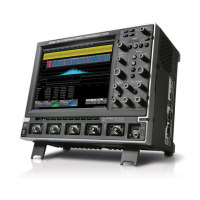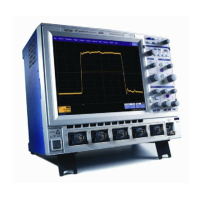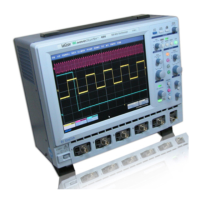X-Stream Operator’s Manual
WM-OM-E Rev I 359
3. Touch the Analog Compare button . The Analog Compare setup checkbox,
buttons, and data entry fields appear.
4. Touch inside the Head Signal field and select a signal source from the pop-up menu. The
choices comprise channel inputs C1-C4, math traces F1-F8, memories M1-M4, or
Reference. See Using Analog Compare for guidelines on using a Reference.
5. Touch the Trace On checkbox to turn the Head Signal on.
6. Touch inside the Read Gate field and select a source from the pop-up menu. The choices
include Ref and none. Read Gate If the Read Gate signal is connected to a DDA-5005A
channel and specified, it will be used to determine the regions of the signal to be analyzed.
If Read Gate is not present, the entire waveform will be used unless the Analyze Region
cursors are enabled.
7. If for Read Gate you selected other than none, Touch inside the Gate Polarity field and
select positive or negative polarity.
8. Touch the Store Head Reference button.
9. Touch the Specify Region checkbox to specify a start and end time, if desired. (This may
be necessary if you are not using Read Gate. If you are not using Read Gate, the Analysis
Region must start with a preamble for VCO synchronization.) Then touch inside the Start
and End data entry fields and enter starting and ending time values from -1.0 ks to +1.0 ks,
using the pop-up numeric keypad.
10. To jump to a position in the head signal, touch inside the "Position" Segment field and
enter a value from 1 to 999, using the pop-up numeric keypad. Then touch inside the Byte
field and enter a value from 50 to 50,000.
11. Touch inside the Worst Error # field and enter a value from 1 to 100, using the pop-up
numeric keypad.
12. Touch inside the Analog Threshold field and enter a value from 0 mV to 1 V.
Channel Setup
Channel Setup is required for Analog Compare, which is the same as for Channel Emulation.
Setting Up Noise Analysis
1. Press the DDA's front panel Drive Analysis button . The disk drive dialogs
appear.
2. Touch the Drive Analysis tab:
